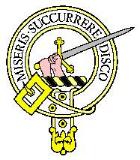
|
|
|

|
|
The MacMillans are an ancient Clan, tracing their origins back for over a thousand
years to the royal house of the Celtic prince, St Columba. This great man established
his church on the Isle of Iona during the sixth century, establishing Christianity in
Gaelic Scotland. The order of the Columban church allowed priests to marry, and so the
MacMillans descend from the clergymen of Iona. The Clan MacMillan progenitor was Gille
Chriosd, or disciple of Christ, who was a son of Cormac, the Bishop of Dunkeld. The
name MacMillan comes from the Gaelic "Mac Mhaoilean" meaning "son of the tonsured one",
a reference to the Celtic priestly practice of shaving the front of the head, rather
than following the Roman tradition of baring a ring around the crown.
The Clan moved to the banks of Loch Arkaig in Inverness-shire during the reign of David I in the 12th Century. From there the Clan MacMillan settled in Lawers in Perthshire, Knapdale in Argyllshire, and Galloway. In Knapdale there remains two enduring monumets to the Clan MacMillan. The first is a round tower in Castle Sween, one of the oldest castles in Scotland. This tower was built by Alexander MacMillan, husband of the MacNeil heiress to the castle, and is known as MacMillan's tower. The second monument is a Celtic cross, erected in the churchyard of Kilmory in memory of Alexander. This cross is renowned as one of the finest examples of Celtic artwork, and it depicts the Chief hunting deer for his own larder. MacMillans have been involved in many of Scotland's battles, and were never hesitant to fight for the Scottish cause. In particular, Clan MacMillan played a prominent role in the 14th Century war for Scotland's independence. The MacMillans were steadfast supporters of the Scots king, Robert the Bruce. After Bruce had slain his greatest rival for the throne, the Red Comyn, in a church at Dumfries, the King was forced to flee from the Comyn faction's lust for revenge. Bruce rode to the Highlands, where he was sheltered by the MacMillan chief, Maolmuire, in the most regal style the chief could muster. Maolmuire ensured that his brother Gilbert, Baron of Ken, would accompany Robert the Bruce on his campaigns against Edward I, the infamous English overlord. MacMillans fought beside Bruce at the glorious Battle of Bannockburn in 1314, where the Scots drove the English from their land and reestablished the independence of their nation. Over four centuries later, the members of the Clan MacMillan joined the 1745 Jacobite Rebellion under the banner of Bonnie Prince Charlie. While the Chief refused to support the Prince unless the House of Stewart renounced the Catholic faith, his sons raised the Clan to fight at the fateful Battle of Culloden in 1746. Here both sons laid down their lives for Charlie, and a clansman, Hugh MacMillan, guided the Prince over the hills to Loch Arkaig after his tragic defeat. In the wake of Culloden, many MacMillan Jacobites surrendered to the Duke of Cumberland on the guarantee that they would be offered protection. Instead, they were transported to the Carribean without trial, many never to see their homeland again. Despite this, MacMillans continued to prosper through the centuries and today the chief of the Clan MacMillan resides at Finlaystone House in Renfrewshire. The Clan MacMillan crest is two strong hands brandishing a double-handed sword and the motto of the MacMillans reads "Miseris succerrere disco" meaning, in Latin, "I learn to succour the distressed". Click here. |
| [Home] |